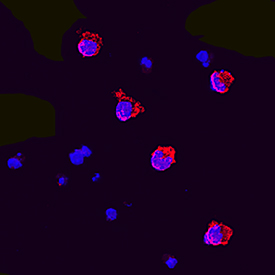Mouse Flt-3 Ligand/FLT3L Antibody Summary
Gly27-Arg188
Accession # P49772
Applications
Mouse Flt-3 Ligand/FLT3L Sandwich Immunoassay
Please Note: Optimal dilutions should be determined by each laboratory for each application. General Protocols are available in the Technical Information section on our website.
Scientific Data
 View Larger
View Larger
Cell Proliferation Induced by Flt-3 Ligand/FLT3L and Neutralization by Mouse Flt-3 Ligand/FLT3L Antibody. Recombinant Mouse Flt-3 Ligand/FLT3L (Catalog # 427-FL) stimulates proliferation in BaF3 mouse pro-B cell line transfected with mouse Flt-3 in a dose-dependent manner (orange line). Proliferation elicited by Recombinant Mouse Flt-3 Ligand/FLT3L (10 ng/mL) is neutralized (green line) by increasing concentrations of Goat Anti-Mouse Flt-3 Ligand/FLT3L Antigen Affinity-purified Polyclonal Antibody (Catalog # AF427). The ND50 is typically 0.05-0.25 µg/mL.
 View Larger
View Larger
Flt-3 Ligand/FLT3L in HT‑2 Mouse Cell Line. Flt-3 Ligand/FLT3L was detected in immersion fixed HT-2 mouse T cell line using Goat Anti-Mouse Flt-3 Ligand/FLT3L Antigen Affinity-purified Polyclonal Antibody (Catalog # AF427) at 5 µg/mL for 3 hours at room temperature. Cells were stained using the NorthernLights™ 557-conjugated Anti-Goat IgG Secondary Antibody (red; Catalog # NL001) and counterstained with DAPI (blue). Specific staining was localized to cytoplasm. View our protocol for Fluorescent ICC Staining of Non-adherent Cells.
Reconstitution Calculator
Preparation and Storage
- 12 months from date of receipt, -20 to -70 °C as supplied.
- 1 month, 2 to 8 °C under sterile conditions after reconstitution.
- 6 months, -20 to -70 °C under sterile conditions after reconstitution.
Background: Flt-3 Ligand/FLT3L
Flt-3 Ligand, also known as FL, is an alpha -helical cytokine that promotes the differentiation of multiple hematopoietic cell lineages (1‑3). Mature mouse Flt-3 Ligand consists of a 161 amino acid (aa) extracellular domain (ECD) with a cytokine-like domain and a juxtamembrane tether region, a 21 aa transmembrane segment, and a 22 aa cytoplasmic tail (4‑6). Within the ECD, mouse Flt-3 Ligand shares 71% and 81% aa sequence identity with human and rat Flt-3 Ligand, respectively. Mouse and human Flt-3 Ligand show cross-species activity (4, 5, 7). Flt-3 Ligand is expressed as a noncovalently-linked dimer by T cells and bone marrow and thymic fibroblasts (1, 8). Each 36 kDa chain carries approximately 12 kDa of N- and O-linked carbohydrates (8). Alternate splicing and proteolytic cleavage of the transmembrane form can generate a soluble 30 kDa fragment that includes the cytokine domain (4, 8). Alternate splicing of mouse Flt-3 Ligand also generates a membrane-associated isoform with a 57 aa substitution following the cytokine domain (4, 5, 8, 9). Both transmembrane and soluble Flt-3 Ligand signal through the tyrosine kinase receptor Flt-3/Flk-2 (3‑6). Flt-3 Ligand induces the expansion of monocytes and immature dendritic cells as well as early B cell lineage differentiation (2, 10). It synergizes with IL-3, GM-CSF, and SCF to promote the mobilization and myeloid differentiation of hematopoietic stem cells (4, 5, 7). It cooperates with IL-2, -6, -7, and -15 to induce NK cell development and with IL-3, -7, and -11 to induce terminal B cell maturation (1, 11). Animal studies also show Flt-3 Ligand to reduce the severity of experimentally induced allergic inflammation (12).
- Wodnar-Filipowicz, A. (2003) News Physiol. Sci. 18:247.
- Dong, J. et al. (2002) Cancer Biol. Ther. 1:486.
- Gilliland, D.G. and J.D. Griffin (2002) Blood 100:1532.
- Hannum, C. et al. (1994) Nature 368:643.
- Lyman, S.D. et al. (1993) Cell 75:1157.
- Savvides, S.N. et al. (2000) Nat. Struct. Biol. 7:486.
- Lyman, S.D. et al. (1994) Blood 83:2795.
- McClanahan, T. et al. (1996) Blood 88:3371.
- Lyman, S.D. et al. (1995) Oncogene 10:149.
- Diener, K.R. et al. (2008) Exp. Hematol. 36:51.
- Farag, S.S. and M.A. Caligiuri (2006) Blood Rev. 20:123.
- Edwan, J.H. et al. (2004) J. Immunol. 172:5016.
Product Datasheets
Citations for Mouse Flt-3 Ligand/FLT3L Antibody
R&D Systems personnel manually curate a database that contains references using R&D Systems products. The data collected includes not only links to publications in PubMed, but also provides information about sample types, species, and experimental conditions.
5
Citations: Showing 1 - 5
Filter your results:
Filter by:
-
Hto, Tritiated Amino Acid Exposure and External Exposure Induce Differential Effects on Hematopoiesis and Iron Metabolism
Authors: JM Bertho, D Kereselidz, L Manens, C Culeux, V Magneron, J Surette, M Blimkie, L Bertrand, H Wyatt, M Souidi, I Dublineau, N Priest, JR Jourdain
Sci Rep, 2019-12-27;9(1):19919.
Species: Mouse
Sample Types: Plasma
Applications: Multiplex Assay -
Acutely malnourished weanling mice administered Flt3 ligand can support a cell-mediated inflammatory response
Authors: LM Hillyer, B Woodward
Cytokine, 2018-07-07;113(0):39-49.
Species: Human
Sample Types: Cell Culture Supernates
Applications: ELISA Development (Capture), Western Blot -
Flt3 permits survival during infection by rendering dendritic cells competent to activate NK cells.
Authors: Eidenschenk C, Crozat K, Krebs P, Arens R, Popkin D, Arnold CN, Blasius AL, Benedict CA, Moresco EM, Xia Y, Beutler B
Proc. Natl. Acad. Sci. U.S.A., 2010-05-10;107(21):9759-64.
Species: Mouse
Sample Types: In Vivo
Applications: Neutralization -
Modulation of marrow proliferation and chemosensitivity by tumor-produced cytokines from syngeneic pancreatic tumor lines.
Authors: Blumenthal RD, Reising A, Leon E
Clin. Cancer Res., 2002-05-01;8(5):1301-9.
Species: Mouse
Sample Types: Whole Cells
Applications: Neutralization -
A secreted and LIF-mediated stromal cell-derived activity that promotes ex vivo expansion of human hematopoietic stem cells.
Authors: Shih CC, Hu MC, Hu J
Blood, 2000-03-15;95(6):1957-66.
Species: Mouse
Sample Types: Whole Cells
Applications: Neutralization
FAQs
No product specific FAQs exist for this product, however you may
View all Antibody FAQsReviews for Mouse Flt-3 Ligand/FLT3L Antibody
There are currently no reviews for this product. Be the first to review Mouse Flt-3 Ligand/FLT3L Antibody and earn rewards!
Have you used Mouse Flt-3 Ligand/FLT3L Antibody?
Submit a review and receive an Amazon gift card.
$25/€18/£15/$25CAN/¥75 Yuan/¥2500 Yen for a review with an image
$10/€7/£6/$10 CAD/¥70 Yuan/¥1110 Yen for a review without an image




